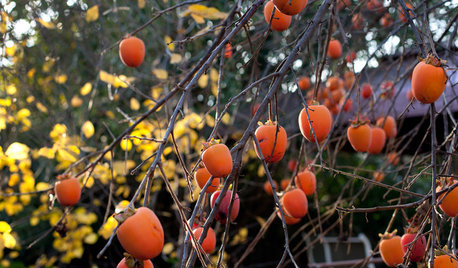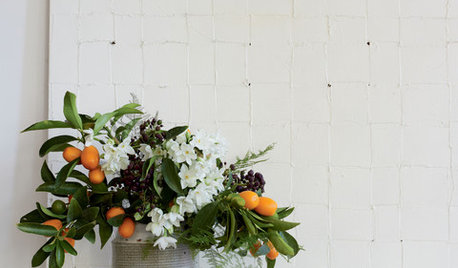persimmon fruit fall............
catherinet
10 years ago
Related Stories

EDIBLE GARDENSGreat Design Plant: Persimmon
Combining beautiful fruit, vivid fall leaves and low maintenance, this tree is a winner in the garden
Full Story
FRUIT TREESHow to Grow Your Own Persimmons
Sturdy and easy to care for, these trees offer bright fruit through winter — and keeping them in bounds is no sweat
Full Story
DECORATING GUIDESPut Your Best Fruit Forward in Splendid Fall Arrangements
Luscious, colorful and unbeatably fresh, fruit-centered arrangements bring welcome flavor to fall home decor
Full Story
EDIBLE GARDENSHow to Grow 10 Favorite Fruit Trees at Home
Plant a mini orchard in fall, winter or early spring to enjoy fresh-off-the-tree fruit the following year
Full Story
FALL GARDENING5 Fall Fruits You Can Grow in Containers
Brighten your porch or patio with a potted pomegranate, kumquat, blueberry bush or another great fall fruit
Full Story
GARDENING GUIDESGreat Design Plant: Grow Blueberries for Their Fruit and More
Eastern gardeners should consider growing blueberry plants for their delicious fruits, bee-friendly spring blooms and brilliant fall foliage
Full Story
GARDENING AND LANDSCAPINGCrazy for Fruit Trees
Whether a single citrus or a mini apple orchard, even the smallest landscape space can bear deliriously delicious fruit
Full Story
FARM YOUR YARDIf You Have Room for Only One Fruit Tree ...
Juice up a small garden with one of these easier-care or worth-the-effort fruit trees for a mild climate
Full Story
MOST POPULARHow to Get Rid of Those Pesky Summer Fruit Flies
Learn what fruit flies are, how to prevent them and how to get rid of them in your home
Full Story
EDIBLE GARDENSGrow Plum Hybrids for Your Favorite Fruit Flavors
Plums are cozying up with apricots, peaches and even cherries — here’s how to grow these hybrids for the best aspects of each
Full Story







lucky_p
catherinetOriginal Author
Related Professionals
Essex Landscape Architects & Landscape Designers · Kenmore Landscape Architects & Landscape Designers · Aloha Landscape Contractors · Blue Springs Landscape Contractors · Bound Brook Landscape Contractors · El Sobrante Landscape Contractors · Morrisville Landscape Contractors · Northport Landscape Contractors · Riverview Landscape Contractors · Rockville Landscape Contractors · West Orange Landscape Contractors · Yuba City Landscape Contractors · Annapolis Siding & Exteriors · Jupiter Decks, Patios & Outdoor Enclosures · Novi Decks, Patios & Outdoor Enclosuresviburnumvalley
lucky_p
lucky_p
catherinetOriginal Author
lucky_p
catherinetOriginal Author